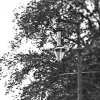oldMohawk
gone but not forgotten
There is a lot of information available about Birmingham Corporation Tramways. It seems that before 1 January 1912 the tram lines were apparently owned by Erdington Urban District Council, but operated by Birmingham Corporation Tramways. The lines passed into the hands of Birmingham Corporation following expansion of the city's boundaries in 1911. It could be that Erdington UDC originally erected the ornate tram poles.Was Erdington once classed as Staffordshire? Would the fancy poles be anything to do with that? Viv.











